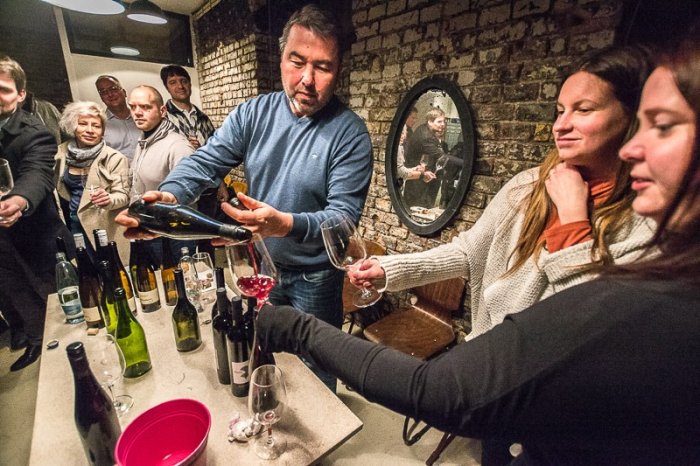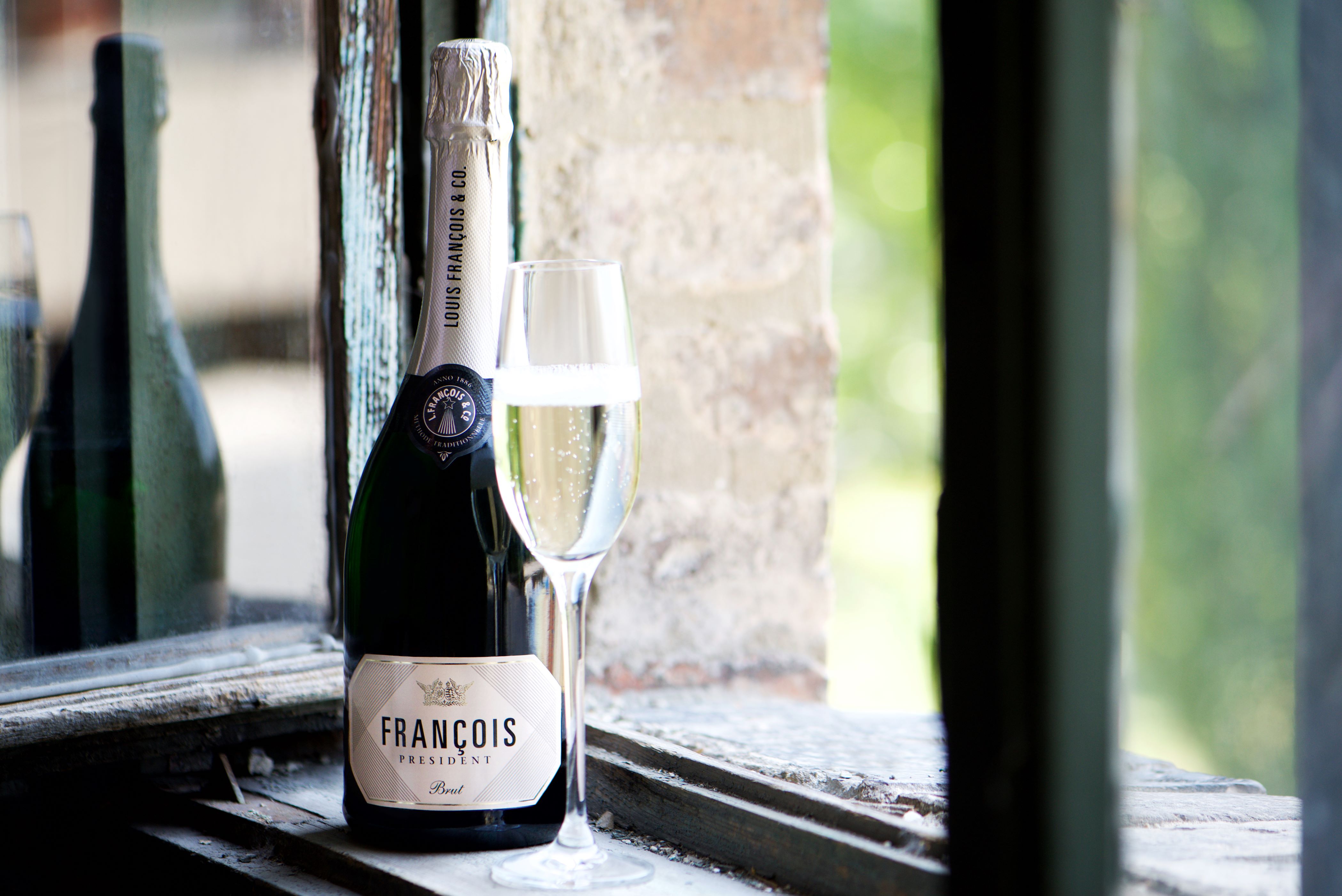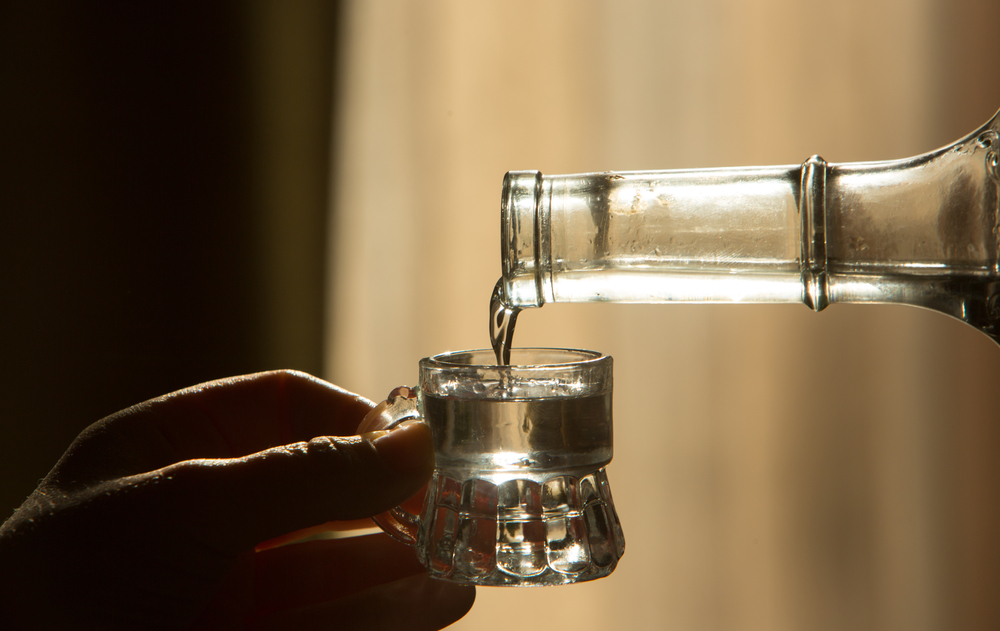Furmint Finding Fame, but Hungary has Much More to its Game

As we wave goodbye to this year’s “Furmint February” and the ever-growing list of tastings related to Hungary’s flagship grape, frenzy for the wine is unabated.
A tasting at the Lodge. Zoltán Horváth of Planina is pouring the wine.
It appears that the country’s great white wine hope is gaining further traction beyond Hungary in the wake of the London-leg of Furmint February, which was attended by a veritable Who’s Who of the British wine-writing scene.
On the back of the tasting held at Merchant Taylor’s Hall on January 29, Furmint even made the Financial Times, where Jancis Robinson MW was upbeat in her commentary entitled “Try Hungary’s Tokaji, but keep it dry”, a reference to the lack of interest in the region’s awesome botrytized sweets wines, which she seriously rates.
She also observed that the effects of climate change have made it more difficult to produce Tokaji Aszú. On tasting lots of 2018 dry wines from Tokaj at the Furmint February Grand Tasting in Budapest, I also found that the hot temperatures that year has even made it harder to make dry wine, with the normally high and invigorating acidity of Furmint tempered a little too much in some cases.
Incidentally, everything appeared to turn out well in 2019 for both dry and sweets (with abundant botrytis occurring) from all accounts and from the few dry wines I’ve tried from last year’s vintage.
Despite the vagaries of the weather, I have certainly felt that the dry Furmint quality bar has been raised significantly in recent vintages, especially as winemakers become savvier and less heavy handed in oak use, or even eschew it altogether, allowing Furmint’s subtle charms to seduce the palate.
Funnily enough, I find myself buying more and more of the stuff. While I would have never have described myself as a skeptic, I did feel that, as a whole, Furmint often lacked focus and flattered to deceive with a lot of fairly average offerings doing the rounds.
For those who missed out on Furmint February, there will be plenty more samples of the wine poured at the Tokaji Március Grand Tasting at the Corinthia Hotel Budapest on March 23 (more than 60% of Tokaj’s vineyards are planted with the grape).
Benchmark
Of course, there’s far more to Tokaj (and Hungarian) wine than Furmint, and when it’s good, Hárslevelű, thought to be an offspring grape, can even usurp it. The Kikelet Winery and its French winemaker/owner Stéphanie Berecz set the benchmark for this variety.
It is without question that Hárslevelű (along with Bouvier) is a parent of the Kabar variety – from which it is also permitted in the making of Tokaj wine. Although it was originally crossed for its propensity to become botrytized more easily than Hárslevelű, this relatively recent addition to the Tokaj fold is also making some exciting dry wines, for example from Tarcal-based winery Füleky, which will be one of 41 Tokaj wineries present at Tokaji Március, which is organized by Winelovers.
There are plenty of other Hungarian grapes to tempt curious palates and I came across a few really interesting ones at Borjour Magnum, a bumper event held at Millináris on February 15; so big, indeed, that it paid to have a tasting strategy. I used it to taste wines from off the beaten track and found several good value and/or distinctive wines made from other indigenous grapes.
The southern town of Mohács is famous for a historic battle and its Busójárás farsang, a colorful and lively carnival in which revelers dress up in scary animal costumes (as was done in the past to chase off invading Turks and/or the evil spirits of winter), which happened last week.
Mohács is less well-known for its wine, although it is part of the Pécs wine region – itself somewhat obscure to outsiders. At Borjour, it was nice to try the wines of Planina Borház and meet its owner/winemaker Zoltán Horváth, who makes wine from five hectares.
Planina’s Királyleányka 2019 (HUF 1,780) is fruity, a touch floral, clean and correct, with zesty acidity, and saves the best to last as it delivers a long, stony finish. It comes from loess soil, although there is limestone lurking deep underneath the topsoil.
Underestimated
Királyleányka is an underestimated varietal that is a natural crossing of Leányka and Grasă that hails from Transylvania. In Romania, it is known as Fetească Regală and is that country’s most planted grape variety.
Much less known is Csomorika, a grape thought to originate from Hungary, which has been used mainly for making sparkling wine (Pécs has a considerable sparkling wine past).
The experimental Horváth of Planina has made a still, dry version in 2019, which has a forwardly floral note that the winemaker himself rightly compares to the Glera grape (the main grape used for Prosecco), followed by a yeasty palate that rather recalls a traditional method sparkler (with the second fermentation carried out in the bottle, albeit without the complexity. This is a wine of contrasts. Planina also works with the Nero and Cirfandli (Austria’s Zierflandler) varieties.
Planina wines are available in Budapest from the Lodge, an exciting new workshop come wine tasting venue and store at Kőfaragó utca 10 in District XIII, which stocks an array of upcoming producers selected by László Folkmann. He originates from Szekszárd and succeeded in getting some small producers from his own region and others into popular District VII bars such as Fekete Kutya and Kisüzem.
While Kékfrankos may be the most planted grape in Hungary, the region of Tolna (close to Szekszárd) is not on most people’s radar when it comes to this red-wine grape. Tolna’s Grál cellar grabbed our attention a few years back when the 2012 came top in a blind tasting organized by Borászportál in 2015, to be named Hungary’s best Kékfrankos.
The 2017 vintage of Pelzberg (HUF 5,600 from www.liberpack.hu), the steep east-facing vineyard from which 90% of the grapes for the wine are grown, is another beauty, with distinctive herbal and cassis notes, a warm and concentrated palate, yet with a lively acidity that cuts through the intensity to deliver a wine of impressive length.

Wine cellar in Tokaj. Photo by DeZet/Shutterstock.com
SUPPORT THE BUDAPEST BUSINESS JOURNAL
Producing journalism that is worthy of the name is a costly business. For 27 years, the publishers, editors and reporters of the Budapest Business Journal have striven to bring you business news that works, information that you can trust, that is factual, accurate and presented without fear or favor.
Newspaper organizations across the globe have struggled to find a business model that allows them to continue to excel, without compromising their ability to perform. Most recently, some have experimented with the idea of involving their most important stakeholders, their readers.
We would like to offer that same opportunity to our readers. We would like to invite you to help us deliver the quality business journalism you require. Hit our Support the BBJ button and you can choose the how much and how often you send us your contributions.










